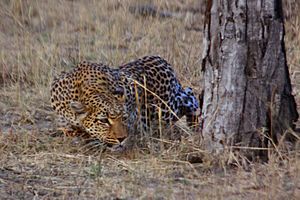Stalking facts for kids
Stalking is when an animal quietly and carefully follows another animal, usually to hunt it. It's like playing a very quiet game of hide-and-seek, but with a serious goal: finding food. Many predators, like lions, leopards, and even some birds, use stalking to get close to their prey without being seen.
Contents
What is Stalking in Nature?
Stalking in nature means a predator moves secretly and quietly to get very close to its prey. The goal is to surprise the prey so it has less time to escape. This hunting method is often combined with an ambush, where the predator waits hidden and then suddenly attacks.
How Animals Stalk Their Prey
Animals use many clever ways to stalk. They try to stay hidden and make no noise. This helps them get close enough for a successful hunt.
Using Cover and Camouflage
Many animals use the environment to hide. They might move through tall grass, behind trees, or among rocks. Their fur, feathers, or skin often matches their surroundings, which is called camouflage. This makes them very hard to see. For example, a snow leopard's spotted coat helps it blend in with snowy, rocky mountains.
Moving Silently
Stalking animals are incredibly quiet. They place their paws or feet down gently, one at a time, to avoid snapping twigs or rustling leaves. Some predators, like owls, have special feathers that let them fly almost silently, making their approach a complete surprise.
Waiting and Watching
Sometimes, stalking involves a lot of waiting. A predator might watch its prey for a long time, learning its movements and habits. They wait for the perfect moment to move, like when the prey is distracted or looking away. This patience is a key part of successful stalking.
Why Stalking is Important for Hunters
Stalking is a very important hunting skill for many animals. It helps them save energy and catch food more easily.
Saving Energy
Running after prey for a long time uses a lot of energy. By stalking, a predator can get very close before the final chase. This makes the chase much shorter and more likely to succeed, saving the hunter's energy.
Increasing Success Rates
When a predator can get very close without being noticed, the prey has less time to react and run away. This greatly increases the chances of the predator catching its meal. It's like getting a head start in a race.
Different Ways Animals Stalk
Not all animals stalk in the same way. Their methods depend on their body, their prey, and their habitat.
Big Cats and Their Stalking
Big cats like lions, tigers, and leopards are masters of stalking. They use their powerful, muscular bodies to creep low to the ground. They use every bit of cover, moving slowly and deliberately until they are just a few leaps away from their target.
Reptiles and Ambush Stalking
Some reptiles, like crocodiles and snakes, also use a form of stalking. They might slowly glide through water or slither through grass, becoming almost invisible. They often combine this slow approach with a sudden, explosive ambush.
Birds of Prey and Aerial Stalking
Birds of prey, such as hawks and eagles, stalk from the sky. They might circle high above, watching for movement below. Then, they glide silently, using air currents, before making a swift, powerful dive to catch their prey.
See also
 In Spanish: Acoso físico para niños
In Spanish: Acoso físico para niños


